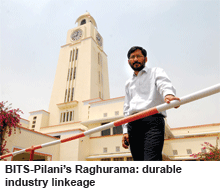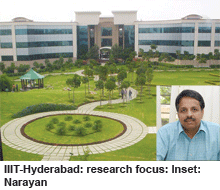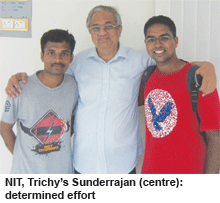Labouring unsung under the long shadow of the country’s celebrated IITs, India’s next-best engineering institutes have received the overdue attention focused on them by the inaugural EW-C fore Engineering Colleges Rankings 2013 as manna from heaven
Euphoria, joy, relief, gratitude and other positive emotions were the reactions of heads and faculty of engineering colleges and technology education institutes when they were informed of the outcome of the EducationWorld-C fore Engineering Colleges Rankings 2013 which excluded Indian Institutes of Technology (IITs) from the rating and rankings exercise.
This is understandable because for several decades the overwhelming majority of India’s 3,400 engineering colleges, the best of whom provide comparable education, have laboured and flowered unsung under the long shadow of the country’s celebrated IITs. The latter invariably dominate rankings of the country’s most admired instit-utions of engineering education conducted annually by a host of publications including the pink newspapers, business and popular magazines.
The suppressed resentment of promoters, managers and faculty of the country’s next-best institutes of technology education against the seven vintage — even if not nine new — IITs is unsurprising. For one, the IITs are the favoured children of the Central government which has constructed these superbly equipped (by Indian standards) institutions and supports them with lavish annual grants ranging from Rs.100-250 crore. This enables them to keep tuition fees rock-bottom low (Rs.60,000-90,000 per year) which in turn attracts the country’s best and brightest students. Moreover, the IITs are supported by the Central and state governments with generous research assignments and grants with private industry following suit.
 On the other hand, the country’s self-financed 1,400 private sector institutes who constitute the majority of engineering colleges countrywide, are under constant pressure to keep tuition fees and faculty remuneration comparable, and are condemned to receive the crumbs of research funding. And as if to rub salt in their wounds they receive minimal attention in the media. Little wonder that labouring unsung — often in locations far removed from glitzy metros — they have received the overdue attention focused upon them by the first EducationWorld-C fore Engineering Colleges Rankings 2013 as manna from heaven.
On the other hand, the country’s self-financed 1,400 private sector institutes who constitute the majority of engineering colleges countrywide, are under constant pressure to keep tuition fees and faculty remuneration comparable, and are condemned to receive the crumbs of research funding. And as if to rub salt in their wounds they receive minimal attention in the media. Little wonder that labouring unsung — often in locations far removed from glitzy metros — they have received the overdue attention focused upon them by the first EducationWorld-C fore Engineering Colleges Rankings 2013 as manna from heaven.
“BITS, Pilani’s #1 ranking in your survey is very welcome and encouraging news in our golden jubilee year, even though we have been topping the private universities rankings of popular magazines such as India Today and Outlook for the past five years. Although this institute has a low media profile, over the past half century we have acquired an excellent reputation within Indian industry. In particular our Practice School Programme under which over 2,000 BITS students together with 50 mentor faculty are placed in over 180 companies has enabled this institute, which was awarded deemed university status in 1964, to establish strong and durable links with Indian industry. This makes it easy for our graduates to find excellent placements every year,” says Prof. G. Raghurama, an alumnus of IIT-Madras and Indian Institute of Science, Bangalore who signed up with BITS, Pilani in 1987 and is currently director of this blue-chip private university of engineering and technology. Currently it has 3,600 students and 300 faculty on its muster rolls, and offers 13 under-graduate, Masters and Ph D engineering degree programmes on its 328-acre campus in Pilani (Rajasthan) through 13 departments and eight specialist schools.
The sustained investment made in premises, people, and pedagogies at the institute promoted by the late G.D. Birla (1894-1983) — pioneer industrialist and favoured disciple of Mahatma Gandhi — over the past 50 years, and the excellent industry reputation that BITS, Pilani enjoys, is reflected in the parameter rankings of the inaugural EW-C fore survey. The respondents to the survey have ranked it #1 on the parameters of infrastructure, industry interface and placements, and second on all others, almost a clean sweep.
 Likewise the unexpectedly high (#2) ranking given by the 2,337 respondents to the inaugural EW-C fore survey of India’s most admired ‘other’ engineering colleges has pleased — even if not enthused — the director and faculty of the International Institute of Information Technology, Hyderabad (IIIT-H, estb. 1998), the country’s first IIIT to be promoted under the public-private partnership model.
Likewise the unexpectedly high (#2) ranking given by the 2,337 respondents to the inaugural EW-C fore survey of India’s most admired ‘other’ engineering colleges has pleased — even if not enthused — the director and faculty of the International Institute of Information Technology, Hyderabad (IIIT-H, estb. 1998), the country’s first IIIT to be promoted under the public-private partnership model.
“Although we are pleased to be ranked high in your survey, IIIT-H is essentially a research university focused on research not only at the Ph D and postgrad levels but also in undergrad education. Therefore we tend to take a long-term view of the impact we make on society and most surveys don’t take this into consideration. Nevertheless I am particularly pleased that IIIT-H has been top-ranked on the parameter of faculty competence and welfare. Our highly-qualified faculty is the greatest asset of this institute and is wholly committed to our institutional object-ives and we do our utmost for their welfare, development and empowerment,’’ says Dr. P.J. Narayan an alum of IIT-Kgp and the University of Maryland and formerly professor of robotics at Carnegie Mellon University who was appointed director of IIIT-H in April.
Though IIIT-H has a low media profile, the institute is highly rated. Last year over 6,000 top-rankers of the AIEEE (All India Engineering Entrance Exam) applied for admission into IIIT-H (total enrolment: 300). Of them, only 200 were admitted into the institute’s undergraduate programmes.
 The recognition and appreciation conferred by the informed respondents of the EW-C fore survey on non-IIT engineering colleges for quietly discharging the vital function of shaping and nurturing human resources in smaller habitations far removed from the bright lights of metropolitan India, is also welcomed by the management and faculty of the National Institute of Technology, Tiruchirappalli (aka Trichy) which has been awarded a #4 all-India and #2 Tamil Nadu ranking. Promoted in 1964 as Regional Engineering College, Trichy, the institute was rechristened NITT and awarded deemed university status in 2003. Coincidentally, like BITS, Pilani, NITT is also celebrating its golden jubilee year.
The recognition and appreciation conferred by the informed respondents of the EW-C fore survey on non-IIT engineering colleges for quietly discharging the vital function of shaping and nurturing human resources in smaller habitations far removed from the bright lights of metropolitan India, is also welcomed by the management and faculty of the National Institute of Technology, Tiruchirappalli (aka Trichy) which has been awarded a #4 all-India and #2 Tamil Nadu ranking. Promoted in 1964 as Regional Engineering College, Trichy, the institute was rechristened NITT and awarded deemed university status in 2003. Coincidentally, like BITS, Pilani, NITT is also celebrating its golden jubilee year.
“I am very pleased to learn in our golden jubilee year that NIIT has been ranked among the top 5 non-IIT engineering colleges countrywide. It reflects the determined effort we have invested in improvement of teaching-learning, research and development and ensuring suitable placements for our graduates. I’m sure our students will also be happy to learn that we are providing them increasingly challenging learning environments within a congenial community,” says Dr. Srinivasan Sunderrajan, an alum of Madurai University and IIT-Madras who came aboard NITT in 2011 and is currently director of this institute ranked highest among the country’s 30 NITs.
In the pages following we present the national league table ranking India’s Top 100 and largely unsung ‘other’ (than over-hyped IITs) institutions of engineering and technology education which are shaping and nurturing engineers urgently needed to develop Indian industry’s inadequate manufacturing capability.
The all-India, state and parameters league tables visit http://www.educationworld.in/rank-engineering/2013.html